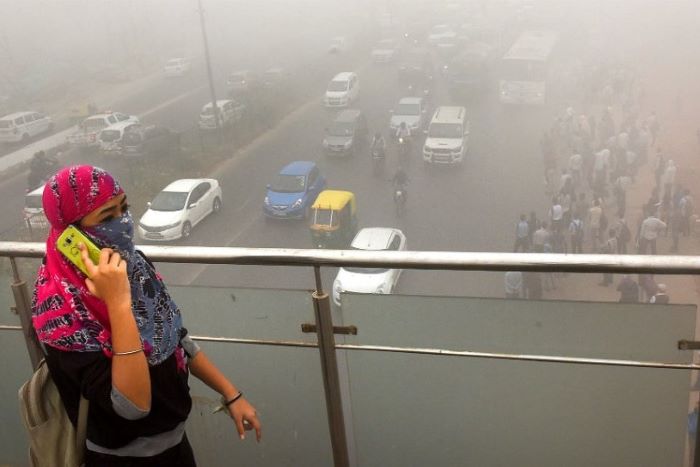Devastated by the pandemic the world was double-masked this year. A Lancet study established that COVID-19 predominantly transmitted through air. The Energy Policy Institute at the University of Chicago (EPIC) research concluded that air pollution can reduce the life expectancy of Indians by nine years inhaling pollutants that are 10 times worse than anywhere else in the world. The study added that clean air policies can add up to five years to people’s lives.
Burning fossil fuels causes one in five premature deaths globally, about 2.5 million people die in India annually, stated a Havard study. Greenpeace and Swiss firm IQAir analysis revealed that air pollution caused around 54,000 premature deaths in New Delhi last year. Over 120,000 people died all over India, according to the report. The worrying linkages between air quality and mortality were expanded further in a study published in the medical journal The Lancet which found that an estimated 349,681 pregnancy losses per year in south Asia were linked with air pollution.
In France, a landmark court ruling for the first time cited air pollution in an extradition hearing as it stopped the deportation of a Bangladeshi man with asthma after his lawyer argued that he risked the possibility of premature death because of the dangerous levels of pollution in his homeland. New research revealed that teenage girls exposed to high levels of biomass burning are shorter in height in the following years. Air pollution from European coal plants could be causing nearly 34,000 premature deaths and a US research found that air pollution from agricultural activities, including animal farming, causes more than 17,000 annual deaths across the United States.
In India, the Centre allocated ₹2217 crore to fight air pollution in 42 cities with over a million residents this year. Last year’s budget was ₹4400 crore, most of which was not spent. The National Clean Air Programme (NCAP), however failed to make a mark on pollution levels in the country. For the third consecutive year, New Delhi was the world’s most polluted capital in 2020, according to IQAir. Thirty-five of the world’s 50 most polluted cities were found in India. The study found that around 54,000 premature deaths were reported in New Delhi in 2020. The Delhi government’s Cabinet approved a real-time source apportionment study to curb air pollution in the National Capital Region (NCR). 64% of PM2.5 descends into Delhi from neighbouring states, according to a source-apportionment study.
While the country has put its weight behind the expansion of liquified petroleum gas for household consumption and cooking in an effort to move away from more polluting bio-fuel sources, a comprehensive survey conducted by the Council on Energy, Environment and Water (CEEW) survey found that 86% of households in urban slums in six Indian states have LPG connections, but only about 50% use them.
Despite the growing disrepute of coal power, the Indian government one again extended deadlines for coal power plants to install emission reduction technology by three years. The deadline had already been extended by 5 years from 2017 to 2022. To fix the issue of government accountability India’s green court, the national Green Tribunal, has constituted an eight-member National Task Force to monitor remedial steps to improve air quality. The Centre allowed some of the most polluting industries to expand their operations by simply providing a ”no increase in pollution load certificate”. According to a new study, air pollution costs Indian businesses $95 billion annually.
The Indian Parliament approved the setting up of the Commission for Air Quality management in the National Capital Region and the Adjoining Areas Bill 2021 that for the first time formally considers air pollution on ‘airshed’ basis, i.e. the entire area over which the pollutants disperse due to meteorological and geographical factors, beyond state boundaries.
India plans to broaden the number of ambient air pollutants it monitors to include ultrafine particulate matter smaller than PM 2.5 by 2022. Currently, India monitors eight pollutants, which include PM 2.5, PM 10, nitrogen dioxide, sulphur dioxide, ozone, carbon monoxide, benzene and ammonia. Air quality data from last year’s Covid-19 lockdown will be used as the baseline for India’s planned revision of air quality standards.
Meanwhile, stubble burning has been decriminalised. A study by EPIC found that air pollution in Delhi was significantly higher (20 times the WHO levels) than the levels reported by the nearest outdoor government monitors.
The World Health Organisation (WHO) released revised and more stringent global Air Quality guidelines saying air pollution damages health, at even lower concentrations than previously understood. The annual PM2.5 levels have been halved to 5 ug/m3 from 10 ug/m3 (2005), while daily mean has been set at 15 ug/m3 from 25 ug/m3 (2005). The latest report on the climate crisis by the Intergovernmental Panel on Climate Change (IPCC)’s declared that air pollutants continue their meteoric rise across India.
About The Author
You may also like
Hyperlocal air quality monitoring identifies pollution hotspots in Indian cities: Study
Meat, dairy industry surpasses fossil fuels in methane emissions: Report
Delhi-NCR most polluted region in India, Karnataka the cleanest air in India: Report
Outdoor air quality chronically underfunded, finds State of Global Air report
PM2.5 shortening average life expectancy of Delhi residents by almost 12 years


